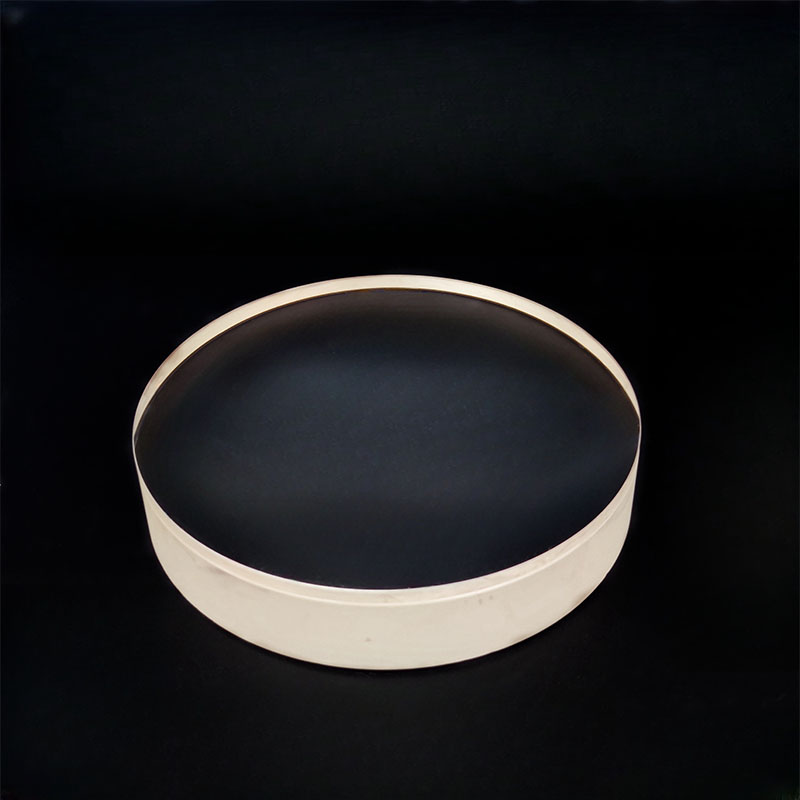
In the process of optical achromatic lens, whether resin cementing method or optical cementing method is used, it must be centered to ensure that the optical axes of the positive and negative lenses coincide. Otherwise, it will affect the image quality of the optical system. When parallel light passes through a non-centered lens group, its focal point image f1' will be displaced to point f2'. Several axes coincide. Rotating the positive lens will also rotate the image point f2'. Its limit orientation is the middle principle of f3' cementing as shown in Figure 8-5. The distance between the two extreme azimuth angles of the image point f2'f3' corresponds to twice the center error of the lens. F1', f2', and f3' coincide when cemented in the middle. Therefore, before the adhesive layer on the cemented surface cures, the positive lens is pushed forward with reference to the optical axis of the negative lens, ensuring the optical axes of the positive and negative lenses coincide. At this time, the image point f2' does not jump, or the jump distance (f2'f3') is within the permissible range. The optical axis of the center and edge lenses initially coincides with the geometric axis. When the cementing agent is in a liquid state, placing the cemented lens on a leveling platform (the surface in contact with the workbench must be convex or flat) allows the lens's center of gravity and its optical axis to automatically reposition through the self-weight of the parts. The method of placing the lens is by adjusting the level using a 30-inch level gauge. The surface accuracy required by this method is N=3, N=0.5, or higher. This centering method can be used for cemented parts with a center error of C>=0.05 mm.
Optical Achromatic Lens are usually made by bonding two or more lenses together using an optical adhesive. The manufacturing process mainly includes the following steps: Material selection and preparation: First, select high-quality optical glass materials such as BK7, Fused Silica, etc. The purity and uniformity of the material directly affect the optical performance of the lens. The glass material needs to be cut, ground, and polished to achieve the required geometric shape and surface quality. Surface treatment: The lens surface needs to be finely polished to achieve high-precision surface smoothness. The polished lens surface should be free of scratches, bubbles, and other defects. Adhesive selection and application: The choice of optical adhesive is crucial, commonly used adhesives include UV-curing adhesive, epoxy resin, etc. The adhesive needs to have high transparency, low shrinkage, and good adhesion properties. During the application process, the adhesive layer must be uniform to avoid the inclusion of bubbles and impurities. Cementing and curing: The two lenses are aligned and bonded together, ensuring optical axis alignment. Then, the adhesive is cured using methods such as UV irradiation or heating. During the curing process, temperature and time must be strictly controlled to prevent deformation or stress concentration in the adhesive layer. Post-processing and inspection: After cementing, the lens needs to be cleaned and post-processed to remove excess adhesive and impurities. Finally, the optical performance of the lens is tested using equipment such as interferometers and spectrometers to ensure it meets design requirements.
Quality control of optical achromatic lens runs through the entire manufacturing process and mainly includes the following aspects: Material inspection: Strict quality inspection of optical glass materials to ensure their purity and uniformity. Common inspection methods include spectral analysis, refractive index measurement, etc. Surface quality control: Inspection of the lens surface smoothness and defects using equipment such as interferometers and microscopes to ensure it meets design requirements. Adhesive quality control: Testing the transparency, adhesion properties, and curing characteristics of the adhesive to ensure it meets usage requirements. Cementing process control: Strict control of adhesive layer thickness, curing temperature, and time during the cementing process to avoid stress concentration and deformation. Optical performance inspection: Comprehensive testing of the optical performance of the cemented lens using equipment such as interferometers and spectrometers, including parameters such as transmittance, refractive index, and wavefront distortion.
Optical achromatic lens are those that can change the direction of light transmission and alter the relative spectral dispersion of ultraviolet, visible, or infrared light. In a narrow sense, optical achromatic lens refer to colorless optical achromatic lens. Optical achromatic lens can be used to manufacture lenses, prisms, mirrors, and windows in optical instruments. The difference between achromatic cemented triplets and other glasses is that achromatic cemented triplets act as components of optical systems and must meet optical imaging requirements. Hence, determining the optical quality of achromatic coated lenses involves some specific and stringent indicators. First, the specific optical constants and consistency of the optical constants of the same batch of glass as given by regular standards for different wavelengths. These serve as the foundation for optical designers to plan optical systems. Therefore, the optical constants of factory-produced optical achromatic lens must be within certain tolerance ranges of these values. Otherwise, the actual imaging quality will not match the expected results during planning, affecting the quality of optical instruments. Second, high transparency: The brightness of imaging in optical systems is proportional to the transparency of the glass. The transparency of optical achromatic lens for a given wavelength is indicated by the light absorption coefficient k λ. As light passes through a series of prisms and lenses, part of its energy is absorbed by the medium (glass) itself. Thus, for optical systems comprising multiple thin lenses, the primary method to improve transmittance is to reduce reflection loss on the lens surface, e.g., by coating the surface with an antireflective coating.